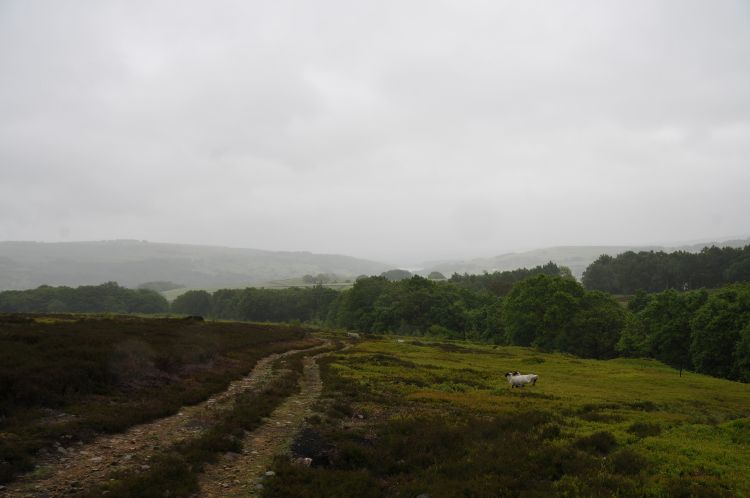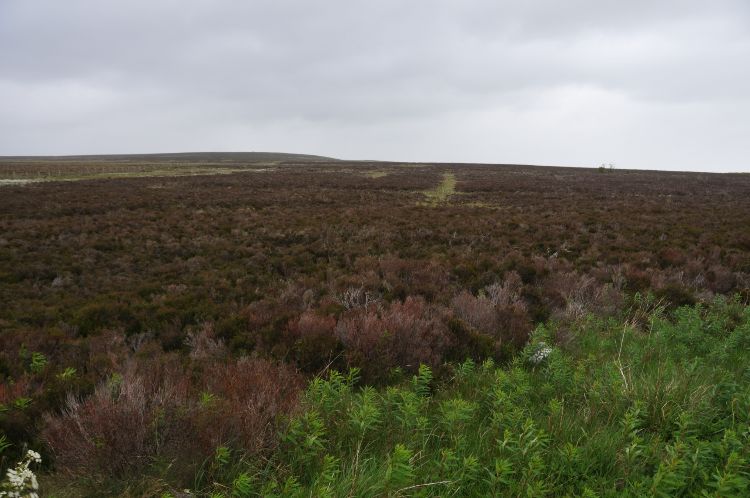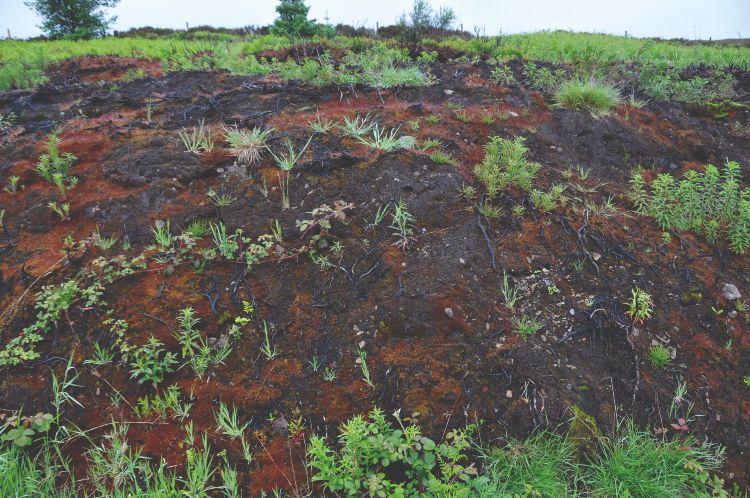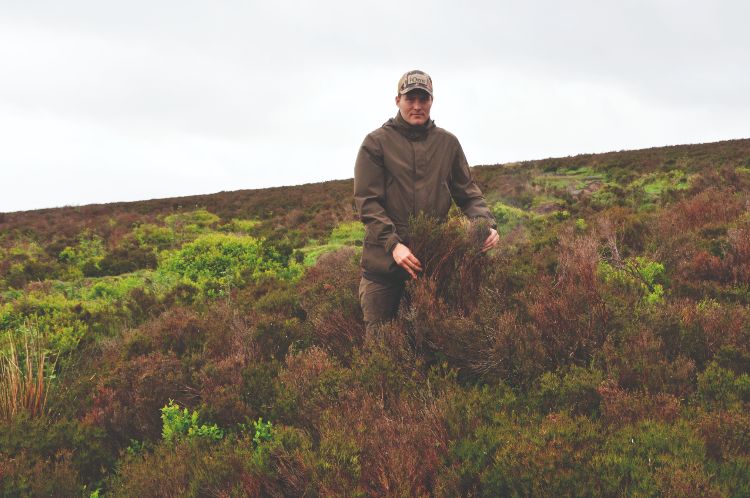Upland conservation: cease fire, cease progress!
Joe Dimbleby takes a look at a ground-breaking new report, which shows that the abandonment of heather management in the Peak District threatens both rare birds and peatlands.

Estate Facts
- Location: Fitzwilliam Wentworth Estate, Derwent Edge, Peak District
- Type of farming: sheep
- Conservation measures: wildfire risk assessment, controlled burns, cutting, gully blocking, extensive grazing, predation management, tree planting, sphagnum planting

Focused on 38,000 acres of the Derwent Valley area, the project was based on a pioneering combination of fire behaviour analysis by co-authors Incendium Group (the experts) and local knowledge of land managers on the ground (the practitioners). The project produced an evidence base to inform future mitigation strategies, including a heat map demonstrating the potential for flame lengths up to 7.6m and rates of spread 2,393m/hour, making it way beyond the fire and rescue service’s capacity to control.
Anthony Barber-Lomax, former resident agent at Fitzwilliam Wentworth Estate and co-author of the report, said: “The modelling revealed that without intervention to mitigate the risk, the fuel load is such that a blaze could become uncontrollable over a huge area. It’s not a case of if, but when.”
Commenting on the report, Andrew McCloy, chair of National Parks England, said: “It is really heartening to see such proactive work from the moorland community. This cements our relationship; it’s about working together. National parks are a national asset in largely private hands, and we can only deliver for the government for population, nature and climate in partnership.”
 A dangerous combination
A dangerous combination
A combination of factors has heightened the risk of wildfire in recent years. Less rain and warmer weather in spring and summer caused by climate change has dried out vegetation. Higher visitor numbers – there are on average 13 million visits every year – means more chance of a barbecue, campfire or cigarette starting a blaze. But of greatest concern to many land managers is the increase in combustible vegetation or ‘fuel load’ caused by a change in management practice.
Where previously controlled ‘cool’ burning of the surface vegetation was carried out to rejuvenate heather and other moorland plants, which are naturally adapted to burning, this practice was recently banned on deep peat in designated areas and is largely discontinued on huge areas of moor owned by conservation organisations and local councils. As a result, the firebreak effect of controlled burns has been dramatically reduced, and the heather on vast swathes of moorland has grown tall, bracken has encroached, and birch scrub is beginning to take hold, all contributing to a massive build-up of combustible material.
In some areas, controlled burns have been replaced by cutting the heather or rewetting the peat to make it more fire resistant by blocking up drainage gullies and damming streams. Nick Gardner, habitat manager on Bradfield Moor, part of the Fitzwilliam Wentworth Estate, believes these measures play a part but are no substitute for managed burning when it comes to reducing the destructive power of wildfire.
He said: “The trouble with cutting is you are not getting rid of the fuel load – you are just dropping it to the floor. I’ve strategically burned up to cut areas whilst fighting wildfires in the past thinking I’d use it as a stop, but it just goes over. Like most other grouse moors we’ve rewetted natural gullies eroded by nature over time. Rewetting will slow the spread and protect deep peat to some extent, but fire will still travel through those areas.”
Those calling for further restrictions on managed burns claim there is a consensus around the scientific evidence that it releases far more carbon than alternatives, both in the act of burning and by drying out the peat.
Risk in numbers
Intensity beyond Fire & Rescue Service control:
- 3.4m flame length
- 800m/hour rate of spread
Potential intensity according to new report:
- 7.6m flame lengths
- 2,393m/hour rate of spread
 Study challenges perception of burning
Study challenges perception of burning
However, Andreas Heinemeyer, Associate Professor of Environmental Research at the University of York, contests this. He has undertaken a 10-year study comparing the carbon budgets of so-called ‘cool burns’, cutting, and simply leaving the heather to grow rank. He would like his study to be allowed to continue on the grounds that a 20-year cycle will give a much clearer picture as it captures the full management cycle, but his findings already challenge the view that cool burns have the biggest net carbon emissions.
He said: “What we have found is that, considered over the first five years, burning equates to a big loss of carbon, whereas with cutting you have not lost to combustion, but you then start to lose carbon through decomposition of the brash year on year. Certainly, over 10 years, it looks like burning does not have the anticipated large carbon loss, particularly when you add charcoal production into the process, which is a long-term carbon store. The other alternative to cutting is rewilding, or just letting it grow, but you will get a build-up of fuel and large amounts of biomass transpire a lot of water. The Peak District is already an inherently dry area, so this will increase peat decomposition by drying it out further and also the risk of the peat burning in a wildfire.”
The role of grouse managers in conservation
As well as reducing areas of overgrown vegetation, grouse managers play a vital role in the prevention and containment of wildfires, providing what is, in effect, a privately funded fire and rescue service.
Nick said: “When there is a wildfire, gamekeepers often spot it first as we are out on the ground. Even if it’s not on your moor, the message goes out that there’s a wildfire and everybody turns up – it’s like having a rapid response team.
“We also know how to access difficult areas of the moor, avoiding obstacles like gutters and hags. The fire departments are always grateful when we turn up with our ATVs with fogging units. They only have backpacks that hold 10 litres of water whereas we’re coming up with 500 litres and they are restricted in terms of how late they can stay, but we’ll stay out until it’s out.”
 The risk of leaving moors unmanaged
The risk of leaving moors unmanaged
If they remain unmanaged, large parts of the Peak District also risk losing local populations of some of the UK’s most threatened bird species, many of which are listed on the national park’s many designations. In contrast, wader species on Peak District grouse moors far exceed the national figures, with curlew and golden plover thriving on the mixed heights of vegetation created by controlled burning and benefitting from predation management carried out by the gamekeepers.
Anthony said: “It’s the predation management that is the key measure. That is understood by conservation organisations, and they do instigate a certain amount, but they come under a lot of pressure because that’s not really what the public expect of them, so they are stuck between a rock and a hard place trying to protect the birds.”
Another potential negative impact from the light touch management of moorland is the effect of the natural regeneration of woodland on waders and ground-nesting raptor species. Tree planting on peatland is restricted, but this will not protect moorland from self-seeding trees. Nick and other keepers across the Peak District invest a lot of time and effort removing saplings before they become trees, by which time they cost far more to remove.
As if loss of habitat and predation pressure weren’t enough, a huge increase in the tick burden in recent years poses a threat to waders and grouse, as it can prove fatal to their chicks. One of the only ways to reduce the number of ticks on the hill is to use sheep dipped in insecticide as mops to pick them up, but many moors are no longer grazed, and Natural England has restricted the number of sheep allowed on Bradfield Moor. Anthony feels the right balance has not yet been achieved.
He said: “We have 400 ewes on 3,500 acres. It’s nothing; they may as well not be there and so as a result we’ve got scrub vegetation coming in places, the presence of which conflicts with the habitats designated by the SSSI.”
The sheep issue illustrates the difference between what could be termed ‘desk top conservation’ decided by remote policymakers, and the approach of the habitat mangers on the ground, or ‘working conservationists’, who are constantly monitoring what’s happening and attempting to adapt measures to suit.
After seeing birds struggling, Nick sent some chicks for post-mortem, which showed they had died from blood loss due to tick infestation. He would now like to decrease tick habitat by removing bracken and control them by increasing sheep numbers, both of which are restricted. The objectives of Natural England and the moorland habitat managers are the same – to protect vulnerable species – but the former appears hampered by policy rather than focused on outcomes.
Common goal
The same is true for managing moorland vegetation: there is a real risk that restricting burning in favour of cutting or abandoning management altogether will be counterproductive and fail to meet the common goal, which is to protect the vital carbon sinks that are the UK’s unique heather moorland ecosystems.
Andreas said: “We need to have an adaptive management approach because we don’t have the scientific evidence that burning is always bad, that cutting is always better, or that doing nothing will achieve what we want.”
Research in practice
Cutting can damage sphagnum moss
Dr Siân Whitehead, Postdoctoral Research Scientist, GWCT English Uplands
In England, regulations were recently updated to restrict heather burning following reports of negative effects, and this has led to a shift toward heather cutting. Results from our 2020-21 heather cutting experiment on grouse moors in Upper Teesdale showed that while cutting reduced vegetation height by an average of 62%, moss depth fell by nearly 40%.
When the cut areas were assessed, it was clear that in some places the important peat-building sphagnum mosses had been ‘scalped’ and other mosses had been completely removed. We also found that cutting resulted in a largely flat and uniform surface, regardless of the size or complexity of the moss hummock and hollow structure that was present before cutting.
Our results indicate that heather cutting has an immediate impact on the moss layer and these short-term effects may influence its future response. Given how important healthy moss layers are to functioning blanket blogs, it is vital that long-term monitoring of cut vegetation is conducted.
To be a sustainable alternative to heather burning, the negative effects of heather cutting need to be mitigated by benefits to land management and the ecosystem, and these need to be considered in relation to the emerging evidence around the effects of burning.




 A dangerous combination
A dangerous combination Study challenges perception of burning
Study challenges perception of burning The risk of leaving moors unmanaged
The risk of leaving moors unmanaged
